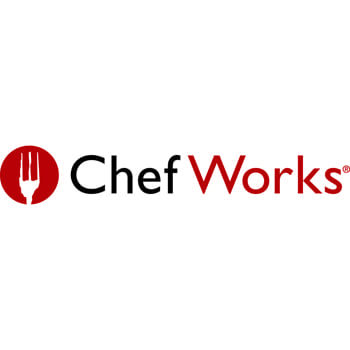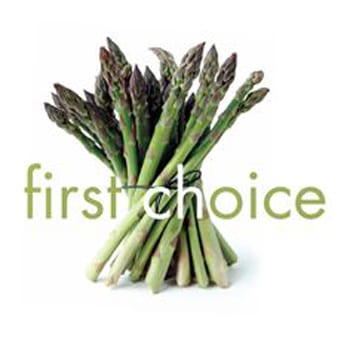A New Dawn in Low Temperature Cooking
It was always going to happen. The same technology which has driven a resurgence in combi ovens has now reached sous vide water baths and vacuum packing machines, which is truly revolutionary for kitchens and chefs who love low temperature cooking.
“Combi technology comes to Sous Vide”
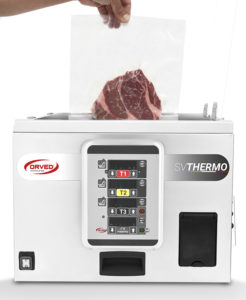 It is now possible to buy a new level of vacuum packing, that can inject gas into vacuum bags so chefs can now seal bags of delicate ingredients such as salads. Up until now this technology has not been available in standard kitchens. This one piece of news alone is very exciting, as kitchens evolve and menus see a new dawn of development.
It is now possible to buy a new level of vacuum packing, that can inject gas into vacuum bags so chefs can now seal bags of delicate ingredients such as salads. Up until now this technology has not been available in standard kitchens. This one piece of news alone is very exciting, as kitchens evolve and menus see a new dawn of development.
However, the cycle of technology has not stopped there. A new breed of water bath is now on the market which comes with its own water supply connection and multiple probes that can actually be inserted through a new type of seal which can be fitted to cooking vacuum bag. This allows you to accurately register the core temperature of anything in the bath as well as the surrounding water temperature.
Low temperature cooking has become very popular in kitchens. The lower temperatures allow food to be cooked more gently for longer resulting in different textures and different flavours that can be added to sealed bags.
 What has not been possible is to marry the level of vacuum with the precision of an inserted probe. That’s new. Now, chefs can control the exact level of pressure in the vacuum and even inject neutral gas into the bags to handle much more delicate items that can be damaged by too much pressure – think of things like salads and fruits.
What has not been possible is to marry the level of vacuum with the precision of an inserted probe. That’s new. Now, chefs can control the exact level of pressure in the vacuum and even inject neutral gas into the bags to handle much more delicate items that can be damaged by too much pressure – think of things like salads and fruits.
Next, by using a new kind of vacuum bag seal, a probe can actually be inserted into the centre of a piece of meat and the precise temperature can be seen on the screen of the water bath. This means that when the core temperature is reached the cooking process can be stopped – even automatically. And water temperatures can be changed because of connection to the water supply. This is next-level water bathing.
Where combi ovens can now be used 24/7 so it is now possible with water baths than can be operated on timers with incredible precision.
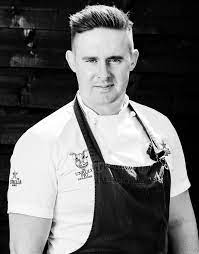 One chef who’s been experimenting with the new technology is Dave Wall at award-winning The Unruly Pig in Woodbridge, Suffolk.
One chef who’s been experimenting with the new technology is Dave Wall at award-winning The Unruly Pig in Woodbridge, Suffolk.
“I’ve been using the new machines and they are precise,” he told The Chefs’ Forum. “I use it to poach a duck liver parfait at an internal temperature of exactly 60˚C for 45 minutes and they turn out perfect. This is amazing technology. Next generation.”
Need to know more? We thought you would.
Imported by Taylor UK and on sale now, the new vacuum packing machines and water baths are manufactured by Orved, Italy.
For more information visit the website: www.taylor-company.co.uk
Would You Pay £65 for a Main Course in London?
Soon you may have to.
In the second of our series on price rises we caught up with chef Marc Hardiman, head chef of Galvin at Windows in London. He told us that by the end of the summer a main course in London would be hitting £65. We sat up and took notice and asked him why.
“It’s simple,” he said, “Everything is going up. Inflation, VAT, wages, ingredients. Everything is going up. My dairy bill went up 22% in a month and one company on my price file raised its ingredients costs by 6% over the same period, across the board.
 “We have tight margins already. Hospitality has notoriously low profit margins – somewhere between 9 – 15% is average – and we can’t pass all this onto the customer but we will have to pass some of it on. It’s inevitable.
“We have tight margins already. Hospitality has notoriously low profit margins – somewhere between 9 – 15% is average – and we can’t pass all this onto the customer but we will have to pass some of it on. It’s inevitable.
“We are already close to that price point in London and I see it happening sooner rather than later. In another year I think we will see who is left in the market. For me there are going to be two tiers of restaurants – those at the top and those at the bottom. Both will be excellent in their own way.
“The luxury market will always be there, but it will have to be value for money. The cost of dining out will not necessarily be an issue but those that charge money will have to deliver. We see ourselves in that bracket but the group at the top will get smaller and you can’t survive in this climate by cutting costs. You have to stay calm and keep doing a brilliant job and look after your customers.
“Conversely, at the lower end there will be brilliant, cheaper food, done properly. That’s already happening with burgers, pizza and everything else. It’s the middle that will get squeezed out.
“In terms of where food it going I think we will see a return to the trolley and to elements of luxury. I don’t think it will go all the way back to where it was. We may see some silver service but I think customers enjoy the fact that there is a chef. It’s still intriguing.
“One thing we have noticed is the hybrid working week. With work at home part of daily life office workers are in the office Monday through Wednesday and that is making Wednesday the new Friday. We are open now Wednesday through Sunday but we only offer lunch on Thursday, Friday, Saturday and Sunday.
“Another thing that I’m seeing is food waste. We have really zeroed in on this and its having a it effect on our food. Take roast beef, for example. We roast the ribs on a trivet of vegetables – onions, carrots, etc – and when the beef is done we take those vegetables and puree them and serve them with the beef. The flavour is immense. That method was not part of the classical canon but now we’re seeing more and more ways of using up everything in a positive way.”
Marc Hardiman talked to The Chefs’ Forum Editor Chandos Elletson.
Being a Food Influencer IS an Actual Job!
Career as a female chef? You must be joking. I’d rather be an influencer
Let’s start with one of the milder comments made to chef Poppy O’Toole – who has successfully traded her working professional career to her current position as a leading chef influencer.
“No-one will ever want to employ you in the your late 20’s as you’ll just get pregnant and people won’t want to pay maternity leave.”
Nice.
Now for one of the more offensive occasions young Poppy had to put up with and one which has serious undertones and should elicit an immediate response of outrage:
“Sit on my lap.”
This barely-believable comment was made during an interview for a chef position.
Here’s another:
“Let me tell you, and the entire kitchen, about an explicit dream I had about you.”
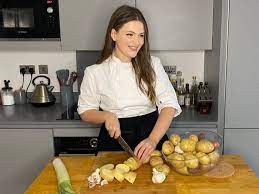 If this is just a fraction of the abuse this remarkable young chef has suffered then our chefs profession is no place for any female chef. Is it any wonder this poor girl said “no thanks” and took back her life and her dignity and went her own way?
If this is just a fraction of the abuse this remarkable young chef has suffered then our chefs profession is no place for any female chef. Is it any wonder this poor girl said “no thanks” and took back her life and her dignity and went her own way?
Poppy Cooks, her online brand, now has a collective reach of 2m followers across social media – and rising. She now welcomes and works with a multitude of sponsors and brands who are only too happy to reach her network. And, get this, she’s achieved that in less than 2 years.
You might have thought the abuse would stop. It hasn’t.
Poppy said: “When I spoke up about a renowned chef who was speaking badly about me on a podcast where he referred to me as “some bird” a new round of abuse started.”
Some of the comments were: “Why can’t you take a joke?”; Feminist gobsh*te”; “Calm down little girl”; “Nothing misogynist about it. Grow up”; “Time to take your girly followers to Benidorm.”
Is this really the way the chefs profession should be treating its female contingent who, after all, are represented by a 3 star Michelin chef in Clare Smyth?
Sadly for Poppy the abuse hasn’t stopped. Here’s some more snippets from social media:
“Sl*g”
“Sl*t”
“You’ve put weight on”
“Get your teeth fixed”
“Good to see women in their natural habitat”
“This is why men are the better chefs”
“Little girl thinks she’s a chef”
“You’re a cook not a chef”
Admittedly, these last set of comments are not necessarily from other chefs and some of them are from American social media where Poppy has a large following. But, what they are, sadly, are representative of what female chefs have to suffer in certain environments even to get a foot on the ladder.
This kind of behaviour has to be stamped out and we at The Chefs’ Forum are outraged. All of us: male and female.
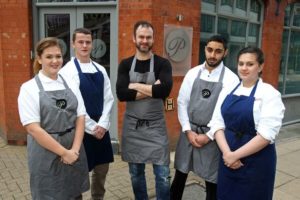 For the record: Poppy O’Toole is a trained chef. She did 3½ years at Purnell’s in Birmingham rising to the rank of CDP. She then moved to The Wilderness in Birmingham and rose to senior CDP. She then moved to London to work as a junior sous at JP Morgan before a spell as Junior Sous at AllBright.
For the record: Poppy O’Toole is a trained chef. She did 3½ years at Purnell’s in Birmingham rising to the rank of CDP. She then moved to The Wilderness in Birmingham and rose to senior CDP. She then moved to London to work as a junior sous at JP Morgan before a spell as Junior Sous at AllBright.
She became an influencer in 2020, during lockdown, and has amassed her followers in less than 2 years.
What does this story tell us? Well, one thing jumps out immediately: a talented, ambitious, young chef gave up her career in professional kitchens. Is it any wonder?
Our own Catherine Farinha caught up with her to talk about her new job and what it has cost her to get there.
“Poppy O’Toole is an amazing example,” explained Catherine. “She gets paid by brands to work with their products. It could be scooters or Koffmann potatoes. She’s now made it all the way to TV – by working hard and not being put off by criticism.”
“When I first started I had nowhere near the following I do now and chefs in particular were quite tough on me,” Poppy said. “It was mainly the US chefs who were particularly harsh as I have quite a large following in the states. The chefs over there seemed to call me out for some reason.
“I’ve been called lazy and work-shy and they are two things that I most certainly am not. I’m like, lazy, me – Are you joking, bab?
“I became a chef because I have a love of eating, so any excuse to be near food was going to work for me. It was always in my blood and I’ve always enjoyed cooking.
“The transition from a chef, to a full time social media influencer was tricky. As a chef I felt I had no work life balance and I was working really unsociable hours.
“Far from being easier now as an influencer it is definitely harder as its constant. I can’t just switch it off for a weekend…its like a beast who keeps needing to be fed. It’s not as intense as chef life, but it is continuous, which I feel needs due credit as its always on your mind.
“In terms of industry keeping up – I feel that hospitality has come very late to the party in using social media to promote itself. I saw all manor of brands and industry sectors take to social media to raise their profile but the culinary sector was a late comer.
“It’s a fact that millennials use social media to plan everything they buy and do – I know I certainly do…I just never dreamt that it would one day become a job for me, but it definitely has!
“I have never studied marketing or business, I am largely self-taught, using lessons learnt amassing a 20k strong audience for my dog with his own account as a sort of a ‘practice run!’
“I absolutely love what I do and can’t really see myself doing anything else. My own brand Poppy Cooks has a combined audience across all social media channels of more than 2 million and I can’t honestly believe it.”
We also spoke to Bettina Campolucci Bordi, another influencer.
“She was doing plant-based on Instagram 6 years ago,” explained Catherine. “She was in first. Now she runs retreats. She has worked in hospitality and she makes good money now. She’ll post at certain times of day to maximise exposure and together with fellow influencers they all work together collaboratively to make things blow up.
Neither of those girls have been to business school – they’ve never done marketing strategy. It’s all self-taught.”
 Bettina said
Bettina said
“When I first started putting pictures up on Instagram it was just to remember my recipes – to remember what I was cooking on my retreats. That’s how it started. I had been a front of house hospitality professional prior to organising wellness retreats. I’ve lived in Spain, Switzerland, and Sweden. I find working with other high-profile influencers – like Nicki Webster, @rebelrecipes and Sarah Popova, @shisodelicious – effective in augmenting my audience with a combined reach of nearly 150,000.
“With Nicki I have a podcast called ‘What the Focaccia’ where we have well known people, farmers and producers in the food industry, and we invite them to give us their views on food and sustainability.
“Sarah is a great friend of mine and our work tends to be more about cooking together in various pop-ups and greatly supports each other’s work.
“In 2018 I launched my retreat chef academy where I teach clients who want to learn more about plant-based food and recipes or for those who want to run their own retreats and cook with others on them.”
Recruitment is About Trust & Understanding – TTW Recruitment Celebrate Ten Wonderful Years!
In an industry where everyone is suffering with a shortage of available personnel trying to fill jobs both back and front of house is virtually impossible.
The trick, according to Charlotte Wade of recruitment specialist TTW, is to build a partnership with clients and see them through the good and the bad times – and to build trust.

Charlotte Wade
“Trust comes first,” Charlotte told The Chefs’ Forum. “Our business has been going for 11 years since Sally and I decided to go it alone and leave our recruitment agency roles in Bristol.
“Like any other business we have grown and specialised and in 2016 we started working with Craig Taylor from what was Taylors Recruitment. Eventually we created TTW to specialise in both back and front of house.
“So far, so normal, but what marked us out and what has enabled us to keep going now is that we started to build strong relationships with our clients says Sally, what we didn’t want was to just fill jobs. We needed their success to help us with ours – and I believe that this mentality is at the root of our current position.
 One of our first clients back in 2012 was Fosters Event Catering, we’ve worked with CEO Neil supporting his recruitment strategy since then and know our success is down to the relationship and understanding of their business, it’s also been great to work with Fosters at venues such as The Box, Westonbirt, Gloucestershire County Cricket Club and Compton Verney.
One of our first clients back in 2012 was Fosters Event Catering, we’ve worked with CEO Neil supporting his recruitment strategy since then and know our success is down to the relationship and understanding of their business, it’s also been great to work with Fosters at venues such as The Box, Westonbirt, Gloucestershire County Cricket Club and Compton Verney.

Sally Wigg
In 2013 Sally relocated to her home in South Devon, ‘a great location for us in terms of the kind of clients we want to be working with, lots of great foodie hotels, pubs & restaurants on my doorstep’ Sally explains. ‘It’s also really beneficial to have a good geographic spread across the region with Charlotte in Somerset and Craig in North Somerset.

Dartington Estate
We are currently working with the beautiful Dartington Estate in recruiting some key roles to enable them to reposition their hospitality offer. This is typical of a bespoke client that we support through exciting periods of change where attracting the right talent is key as well as ensuring they are competitive within the market.
Over the years TTW have adopted a consultative approach and are proud of how they are able to support clients in this way, Charlotte says, ‘we love working with Sarah at Berwick Lodge, a beautiful hotel and Sarah’s passion and enthusiasm is contagious.

Sarah Arikan – Berwick Lodge
“Sarah will call us up and ask for advice on salaries, the market and all manner of other smaller things. We are happy to help because we believe in her business and the longer we work together the stronger the bond becomes.
TTW sponsored The Chefs’ Forum in 2018 and this gave the team the platform to network with south west chefs and hospitality professionals on a regular basis. The events were also a great opportunity to invite clients as their guests. TTW are looking forward to a year of further events throughout 2022 and cannot wait to catch-up with clients and candidates old and new.
Catherine Farinha, Founder of The Chefs’ Forum has also used TTW to enrich and expand The Chefs’ Forum team.
She said
“Six months ago, we sought to expand our team due to an ever-increasing events schedule and expanding estate of Chefs’ Forum Academies on a national level. We knew that TTW was the right recruitment agency for us. Fully-aware of how well the team work to ensure the perfect fit for long term placements. Working at The Chefs’ Forum requires extensive industry knowledge, marketing expertise, as well as excellent levels of customer service, communicating with chefs, hospitality professionals and brands at all levels.

Alice Kamara (left) & Alicia Kember (right)
We were delighted to welcome Alicia Kember and Alice Kamara to the events team and are extremely grateful to Sally, Charlotte and Craig for finding us the perfect ladies to help us fill events with top industry people, running our Academies and keeping our sponsors happy and loyal to The Chefs’ Forum.
Welcome to Team Chefs’ Forum!
 “Another relationship we built up was with The Bath Pub Company. We helped them with chefs and a managers across their pubs but more than that we worked closely on recruitment best practices and supported each other through social media. Since then we have grown together and have a mutual respect.”
“Another relationship we built up was with The Bath Pub Company. We helped them with chefs and a managers across their pubs but more than that we worked closely on recruitment best practices and supported each other through social media. Since then we have grown together and have a mutual respect.”
Sally continued
 “At Dartmouth Hotel, Golf & Spa we worked closely with the GM both in this and his previous resort where we recruited and we’re part of building the right team. This has proved to have been a key to both properties.
“At Dartmouth Hotel, Golf & Spa we worked closely with the GM both in this and his previous resort where we recruited and we’re part of building the right team. This has proved to have been a key to both properties.
“Over the past decade we have been able to really understand both the skills and team dynamics to ensure that we really can find the right people to enable future success. This is a relationship built on trust, honesty and integrity and I believe it’s where the industry needs to go. We are now in the trust-building business and recruitment is just one part of that process.”

Charlotte Wade & Sally Wigg talked to Catherine Farinha.
If you are looking for a great candidate or your next position contact the team at TTW now: www.ttwrecruit.co.uk
The Plant-based Battle for Hearts & Minds
As a long-time writer of all things restaurants I have always had the pleasure of being able to eat the whole menu. Indeed, as a “normal” meat and fish-eating customer I have always relished the term I used to describe as “menu-dilemma”. In other words, there were often more than one dish on the menu that I wanted and the dilemma was in the choosing. It’s a comforting feeling and one that I associate with eating out.
 So, I was very shaken recently during a conversation with our own Events Executive Alice Kamara, who is a vegetarian with vegan leanings, when she told me that more often than not, she feels like an awkward customer and never has the luxury of being able to eat the whole menu.
So, I was very shaken recently during a conversation with our own Events Executive Alice Kamara, who is a vegetarian with vegan leanings, when she told me that more often than not, she feels like an awkward customer and never has the luxury of being able to eat the whole menu.
As soon as she said that I realised that there was something wrong with the way vegans and, to a lesser degree, vegetarians are marginalised in restaurants. To them the luxury of an entire menu dedicated to themselves has been, largely, unavailable save for a number of specific restaurants that cater to them.
“My dream is veggie-only restaurants,” Alice explained. “I’d love to be able to eat the whole menu including desserts. But, so often all I ever get to do is choose an option. I’m a second-class guest.
“Also, and I find this a big problem, I don’t always want a vegan burger or a fruit salad. The state of play at home now is that I can eat well. There are vegan dishes and meat alternatives that make shopping and eating more fun. But the same cannot be said for restaurants.”
Twenty years ago these statements were dismissed as faddish. Just vegans. But, times have changed. The whole world has changed and today vegan philosophy, for the very first time, is in the ascendancy.
Indeed, chefs who are not thinking about their plant-based guests should be and those that are not giving over menu inches to plant-based are missing a trick. By not considering the other half they are missing out on a growing number of would-be guests who have already decided they want to go somewhere else.
“I definitely choose a restaurant now based on the amount I can eat on the menu,” Alice continued.
It’s easy not to want to think about this. It’s easy to say – well, we’ve got some vegan options. But that is no longer enough. Alice’s statement about wanting to be able to eat the whole menu has a substance to it that cannot be ignored.
So, what does it all mean? What does the future hold?
 The recent move by 3 Michelin-starred Daniel Humm may hold a clue. When he decided to go all vegan that did not go down well at Claridge’s where he had a restaurant: Davies and Brooks. They parted ways. Humm’s 3 star restaurant in New York, Eleven Madison Park, is now all vegan. It remains to be seen how other senior restaurants follow suit – and how many customers like Alice vote with their feet.
The recent move by 3 Michelin-starred Daniel Humm may hold a clue. When he decided to go all vegan that did not go down well at Claridge’s where he had a restaurant: Davies and Brooks. They parted ways. Humm’s 3 star restaurant in New York, Eleven Madison Park, is now all vegan. It remains to be seen how other senior restaurants follow suit – and how many customers like Alice vote with their feet.
“I want to eat something that I can’t get at home,” Alice further explained. “Equally, I don’t want to pay £20 plus for a main course of vegetables. Something has to give.”
That’s a good point. The cost of meat and fish is high and is the reason that menus are expensive. But a vegan option doesn’t have that cost associated with it and the perception is that, therefore, it should be cheaper.
“I believe that chefs do not like vegans,” Alice said emphatically.
I thought about that and what it meant.
“I don’t mean that personally,” she went on. “I just mean that we are harder to cook for. A piece of meat or fish is the star of a dish. It contains its own flavours. But vegetables are often harder to flavour and require more thought and work. And we expect them to be cheaper. That’s why I think chefs don’t like us.”
She has a point. So, are there any restaurants that are fulfilling her dream of being able to eat the whole menu?
“Yes!” Alice said. “I was in London recently and had a meal at Clean Kitchen Club. It’s all vegan and it was a treat to know that I could order everything. I’m excited about Purezza – an all vegan pizza restaurant chain and I had a great time at Mildred’s which is a vegan restaurant group.
“It showed me that there is a growing number of restaurants that are slowly getting more sophisticated where I can feel at home and enjoy the whole experience.”
The obvious conclusion of this conversation is that I, too, could enjoy the whole vegan experience as well. Just because I am not a full-time vegan does not stop me from enjoying it some of the time – which is increasing.
The problem chefs face is where to stand. Do you offer an option or do you offer none or do you go all vegan?
“It’s a conundrum,” Alice revealed. “We are not easy to cook for and I understand that but I believe we are a growing force and the more chefs and restaurants embrace us the more we will be tempted out to spend our money.”
What about the new meat and fish alternatives? Are they a way for restaurants to draw in vegans?
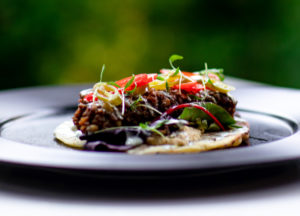 “I like products like redefine meat and This!” Alice said. “However, I don’t always want a meat alternative. I do sometimes. I told you I was difficult! I loved Exose Grant’s Redefine Meat lamb kofta at the 10th Anniversary lunch we had for The Chefs’ Forum in Manchester. It was delicious and it has a place. I had it again at Chotto Matte and Mr White’s in London. It definitely has a place. But plant-based as a philosophy is more than just having an alternative. We want our cake (vegan) and be able to eat it.”
“I like products like redefine meat and This!” Alice said. “However, I don’t always want a meat alternative. I do sometimes. I told you I was difficult! I loved Exose Grant’s Redefine Meat lamb kofta at the 10th Anniversary lunch we had for The Chefs’ Forum in Manchester. It was delicious and it has a place. I had it again at Chotto Matte and Mr White’s in London. It definitely has a place. But plant-based as a philosophy is more than just having an alternative. We want our cake (vegan) and be able to eat it.”
 Alice Kamara talked to The Chef’s Forum Editor Chandos Elletson.
Alice Kamara talked to The Chef’s Forum Editor Chandos Elletson.
Seasonal Guide with Four Seasons: Winter
We’re kicking off a new guide to the seasons with our friends in the Cotswolds, Four Seasons. We enjoyed a great day with chef Daniel Galmiche and some exceptional produce. Here’s what chef proposed!
Follow the seasons
“It’s so important to actually follow seasons,” chef Daniel explained. “There is a good reason for this and in France, Spain & Italy it is all taken for granted and chefs learn these lessons at an early age.
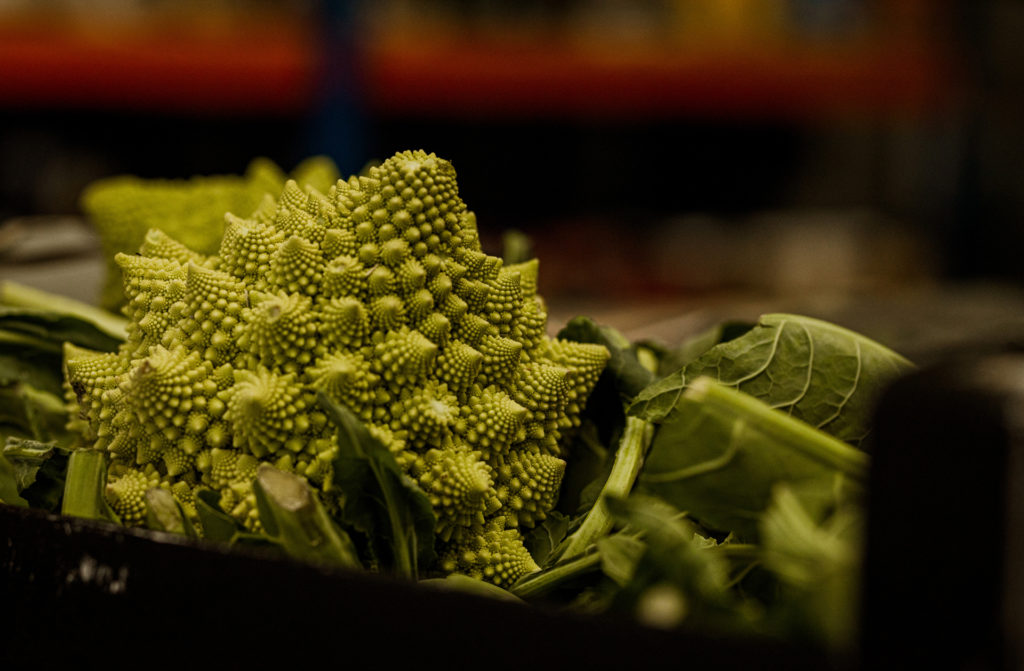 “When you buy a fruit or a vegetable in season it is at its best, its freshest and its cheapest because it is in abundance. This is the best time to use an ingredient. It holds its best amount of nutrition. Everything about it is perfect. It has been grown locally to where you are in perfect conditions. When you buy an ingredient out of season it has often been grown for that purpose in a country that is far away and does not have ideal growing conditions for that ingredient. Consequently, it is more expensive and less ideal from a nutrition point of view.”
“When you buy a fruit or a vegetable in season it is at its best, its freshest and its cheapest because it is in abundance. This is the best time to use an ingredient. It holds its best amount of nutrition. Everything about it is perfect. It has been grown locally to where you are in perfect conditions. When you buy an ingredient out of season it has often been grown for that purpose in a country that is far away and does not have ideal growing conditions for that ingredient. Consequently, it is more expensive and less ideal from a nutrition point of view.”
So, it’s really important to plan for the seasons. Plus, you get to work with amazing produce.
Leeks
I’m excited at the moment by British leeks. Of course we have them in France, too. There is so much you can do with them like young leeks in a vinaigrette. Or roast leeks with a dressing of almond. Leeks go beautifully with eggs, too in a tart or quiche. But don’t forget about the classic soup with potato. And use the green part for colour – the secret to this is to blanch them to retain colour and goodness and add them to the soup when its time to blend. Leeks are fantastic with roast pork.
Ratte Potatoes
These are a French variety and very popular with chefs. They have a nutty taste and a yellows skin. They are a classic potato for boiling, roasting and sautée. I love to combine them with leeks.
Sand Carrots
These are long, orange carrots that have been grown in sand in places like Brittany. They have less moisture and more flavour than regular carrots. Great for carrot soup with cumin or even juiced.
Cima de Rapa
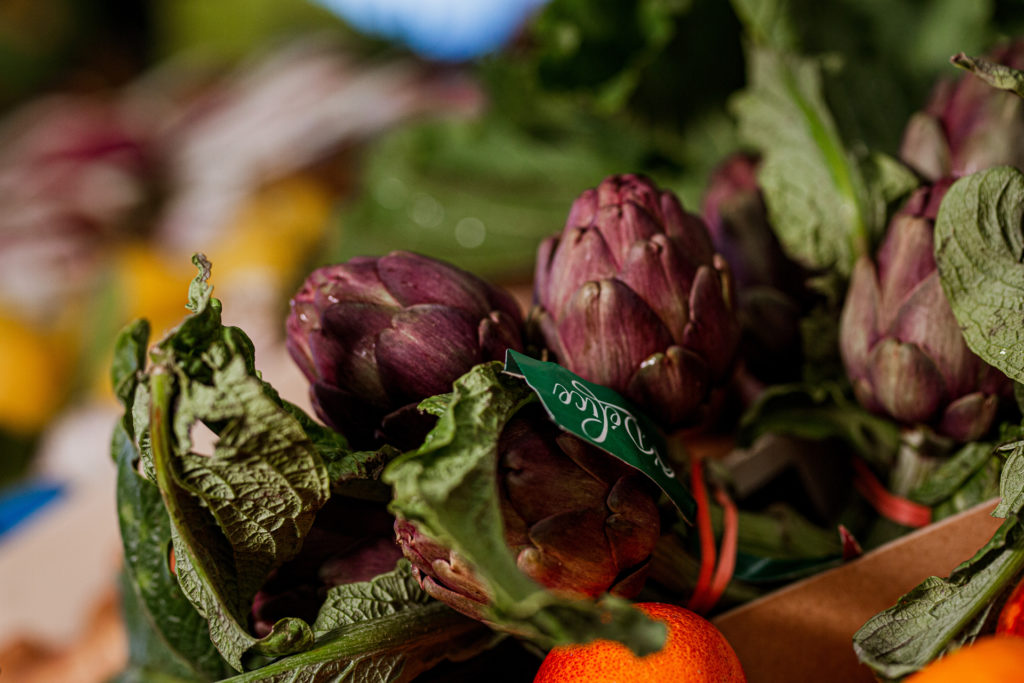 This is known as turnip tops and is a cousin of sprouting broccoli. It’s extremely good for you and the Italians love it. It pairs very well with leeks and pork but also with lamb.
This is known as turnip tops and is a cousin of sprouting broccoli. It’s extremely good for you and the Italians love it. It pairs very well with leeks and pork but also with lamb.
Look out for these as well: Waxy pears, blood oranges, purple artichokes, Italian squash
Daniel Galmiche talked to Alicia Kember. Thanks to Franco and the team at Four Seasons.
Visit Four Seasons website HERE
Welsh Seafood Endorsed by Top Chefs – What’s on Offer?
From Rhyl in the North to Cardiff in the South the dark, churning and crystal clear waters of coastal Wales contain some of the best fish and shellfish in the world.
Pre-Brexit the majority of the catch from this superb fishing ground was being exported but since the reopening of restaurants post-lockdown the Welsh fishing community is keen to keep the best of the haul for the UK home market.
That means chefs can take advantage of unique new access to Welsh lobster, crab, mussels, scallops and sea bass – to name a few of the delicacies that are now available. Welsh Seafood comes from Class A and Class B graded waters – meaning that the water quality is of a very high standard around the coastline.
What’s on offer?
 Lobster
Lobster
Welsh Lobster are caught by fishermen using small day boats – less than 10m on the whole and the method of catching is by using Lobster Pots. Fishers that are taking part in the Welsh Lobster Banding and Branding project have pledged to fish Welsh Lobster sustainably by allowing berried hens to return into the sea to reproduce and secure stocks for the future, and also the use of escape hatches which allows juvenile lobsters to exit the pots as they are below the minimum landing size.
Before they are cooked, lobsters have a dark bluish shell, and gains its distinctive deep orange colour upon cooking. Welsh Lobster are available throughout the year (weather permitting).
Brown Crab
Welsh Brown Crab are caught the same way as lobsters and can be bought live or dressed.
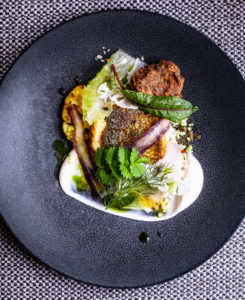 Sea Bass
Sea Bass
Welsh sea bass are completely wild and line-caught from the coast. The distinctive spikes explains its Welsh name of Draenog y Môr, (translated as Hedgehog of the Sea).
Mussels
There are mussel beds and rope grown mussel farms scattered across Wales, from the Menai Straits, to Pembrokeshire.
Scallops
Welsh scallops are not dredged as they are in some other parts of the UK. They are harvested or hand-gathered by divers in some parts of Wales.
Oysters
There are two main oyster varieties available in Wales: The Pacific Oyster and Native Oysters.
Cultivated through Aquaculture and maintaining the seed-beds as a sustainable resource, the more commonly available, and faster growing, Pacific oysters are readily available to buy throughout the year, while the Native oyster, tends to be mostly available from September to April, although it takes twice as long to grow as other varieties and is usually more expensive to buy.
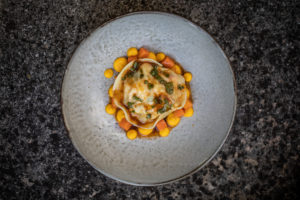 There are two companies specialising in Fresh Welsh Oysters of both Native and Pacific Oysters within the Seafood Cluster – Atlantic Edge Oysters in Pembrokeshire, and Menai Oysters in the North. Both will courier Oysters for delivery anywhere in the UK.
There are two companies specialising in Fresh Welsh Oysters of both Native and Pacific Oysters within the Seafood Cluster – Atlantic Edge Oysters in Pembrokeshire, and Menai Oysters in the North. Both will courier Oysters for delivery anywhere in the UK.
Welsh Fish Facts
Welsh Seafood is not intensively farmed (with the exception of the natural aquaculture in mussels and oysters) and is caught sustainably in the wild and is readily available from our numerous merchants and sole traders. When bought directly from the fisher or the aqua culturist, you can have full provenance of where the seafood was caught, by whom, and into which port it was landed.
Where to Buy
Many merchants and fishermen now offer a courier service anywhere in the UK.
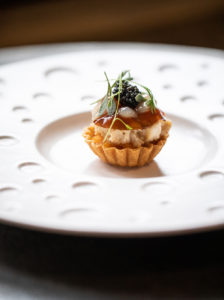 Nia Griffith, North Wales Seafood Cluster Manager said
Nia Griffith, North Wales Seafood Cluster Manager said
“Our coastline is so varied and rich with an abundance of different species but what makes it so special is that our fishermen come from generations of families who’ve always fished. They use small boats and care very deeply for the sustainable nature of the business. It’s their heritage and they want to pass it on.
“When it comes to species like scallops (and lobsters) we take the matter of dredging very seriously. This is done on a small scale and the fishermen actually consider themselves to be conservationists because if they over dredge they ruin the sea bed and with it their livelihood. So, it’s taken very seriously and the chefs that we supply can always rely on that.”
Take a look at these four top chefs creating stunning dishes using Welsh Seafood…
Richard Davies, Executive Chef at Calcot & Spa
“Absolutely stunning lobster from the Welsh Seafood Cluster. Really high in Omega 3 and vitamins A and D. Perfect for anyone on a high protein diet.”
Hywel Jones, Executive Chef at Lucknam Park
“The reason I chose this product is that Welsh crab is some of the best crab I have ever come across. It’s best season is between April and November so a perfect time of year for it.”
David Kelman, Head Chef at Cowley Manor
“I chose to work with Welsh line caught sea bass which is stunning. My dish includes curried cauliflower and cauliflower couscous and well as local, seasonal, herbs.”
Tom Westerland, Head Chef at Crockers Henley
“I love Welsh seafood and it was a pleasure to work with Welsh oysters, mussels and scallops. Absolutely fantastic.”
Wild Boar Butchery with Hanks’ Meat & Game
 If you understand basic pork butchery then the same applies for wild boar. But, it’s worth bearing in mind that because boar is leaner than some traditional pork cuts, like belly, will be less fatty and may need a different cooking method.
If you understand basic pork butchery then the same applies for wild boar. But, it’s worth bearing in mind that because boar is leaner than some traditional pork cuts, like belly, will be less fatty and may need a different cooking method.
The rump and loin of wild boar, like beef, contain the best cuts for steaks and grills with the legs, shanks and shoulder providing the meant for braises, stews and the famous Italian dish of ragu – a perfect meaty partner for a pasta ribbon like pappardelle.
The main considerations for wild boar are potential cooking times and the age of the meat. According to expert butcher Tim Hanks boar needs a slower or longer cooking time
 As boar gets older it gets a more intense flavour and a deeper colour. The time of year it is harvested can also have an effect on how you should approach butchery: at certain times of year like spring and summer the meat can be leaner.
As boar gets older it gets a more intense flavour and a deeper colour. The time of year it is harvested can also have an effect on how you should approach butchery: at certain times of year like spring and summer the meat can be leaner.
Choosing the right cut of wild boar is going to depend on what you intend to do with it. If you are planning the more traditional braise then a fattier cut from the shoulder is where you should be looking. But don’t ignore the shank which on a boar carcass is much more appealing than from a pig.
As Tim Hanks demonstrates in the video there are good cuts to be had from the loin and the rump with off cuts and mince being used for burgers and sausages. Because wild boar is a darker colour than pork and has a more pronounced flavour it can be used instead of beef and this is a good way of approaching it.
Wild boar burgers and sausages offer customers an opportunity to try out a new meat that has all the hallmarks of a classic red meat yet comes from a sustainable and organic source.
The Changing Face of Venison
According to Nigel Sampson of Holme Farmed Venison once a carcass has been broken down and the, so called, premium cuts have been removed – think the loin, saddle and rump – 60% of the carcass remains.
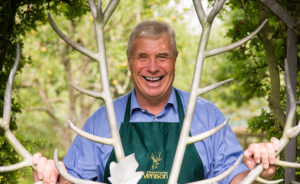 Add to that his observation that sausages, burgers, koftas and mince are all extremely popular by mail order and you start to see that a trend is emerging that restaurant and catering chefs can take advantage of.
Add to that his observation that sausages, burgers, koftas and mince are all extremely popular by mail order and you start to see that a trend is emerging that restaurant and catering chefs can take advantage of.
“Venison mince is naturally low in fat. It’s typically around 95% lean meat and we are seeing a real surge in popularity,” he told The Chefs’ Forum.
Restaurants have historically looked to the prime cuts for their menus but what the public are signalling is that lesser cuts prepared in familiar ways are proving to be really popular. But this is really no surprise.
 Venison meat is healthy, wild, sustainable and available. Eating it helps the countryside and as more more restaurants serve it so the price will come down further.
Venison meat is healthy, wild, sustainable and available. Eating it helps the countryside and as more more restaurants serve it so the price will come down further.
Having a venison burger or a venison sausage on the menu can be a way of bridging the gap for customers who are unfamiliar with how good venison meat can be. And by using the mince to make other dishes – like a venison Bolognese – you can add value to a dish that is not generally considered to be expensive.
For more information, and to order venison and other game please visit www.hfv.co.uk
The New Kisag Kitchen Blender Makes Easy Work of Raja Monkey’s Masala
In the third of a series of real-world trials we took the largest of the new Kisag kitchen blenders, the monster 200l model, to Raja Monkey in Birmingham to see how it performed.
Ready and waiting for us was Munayam Khan who had been busy making up a batch of masala sauce that is the base for the popular chicken tikka masala. This sauce is not easy to make and requires assiduous blending of whole spices such as cinnamon sticks and bay leaves which can be so troublesome for stick blenders to make smooth.
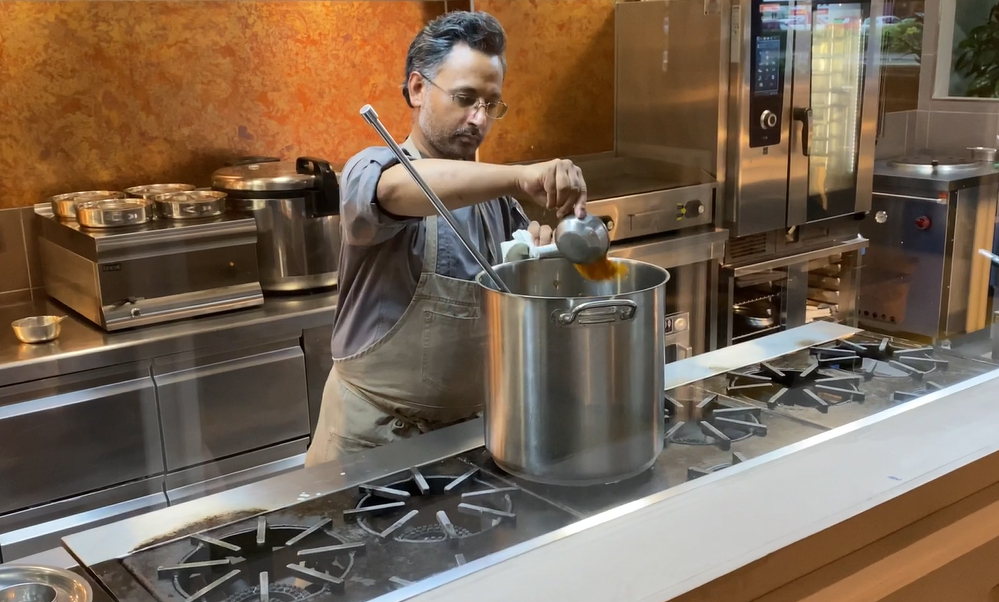 When the sauce was ready Munayam put the blender to the test and it was quickly evident that the sauce was not going to prove much of an obstacle. Indeed, within five minutes the whole thing was smooth and considered ready for use.
When the sauce was ready Munayam put the blender to the test and it was quickly evident that the sauce was not going to prove much of an obstacle. Indeed, within five minutes the whole thing was smooth and considered ready for use.
“It’s a great addition to our kitchen,” Munayam enthused. “It was both quiet and fast. This would normally have taken twenty minutes but it handled it with ease.”
Watch the film to see the whole trial and the complete interview:

